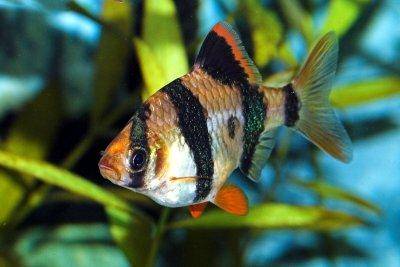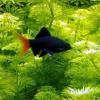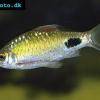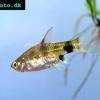Tiger barb - Puntius tetrazona
Scientific name: Puntius tetrazona
Common name: Tiger barb
Family: Cyprinidae
Usual size in fish tanks: 6 - 7 cm (2.36 - 2.76 inch)
014
Recommended pH range: 6.5 - 7.5
Recommended water hardness: 4 - 12°N (71.43 - 214.29ppm)
0°C 32°F30°C 86°F
Recommended temperature range: 20 - 25 °C (68 - 77°F)
The way how these fish reproduce: Spawning
Where the species comes from: South Asia
Temperament to its own species: aggressive/territorial
Temperament toward other fish species: aggressive/territorial
Usual place in the tank: Middle levels
Origin
The Tiger Barb (Puntius tetrazona) originates from South-East Asia, naturally found in Malaysia, Indonesia, and Borneo. Due to their popularity in the aquarium trade, some keepers have released them into the wild, leading to established populations in various countries, including Australia, Singapore, and some regions of South America. In their natural habitat, they inhabit clear and slow-moving waters with abundant vegetation and submerged roots.
General Care
Tiger Barbs are highly active schooling fish that require plenty of open swimming space while also benefiting from planted areas and hiding spots. To replicate their natural habitat, provide an aquarium with fine gravel or sand substrate and include driftwood, rocks, and live plants for cover.
While they are relatively hardy and adaptable, maintaining stable water parameters is key to their well-being. The ideal water temperature ranges from 20 - 25°C (68 - 77°F), with a pH between 6.5 and 7.5. Slightly acidic, well-filtered water with moderate flow mimics their natural environment.
These fish are well-known for their fin-nipping behavior, which can be problematic in a community tank. To reduce aggression, they should always be kept in groups of at least 6 individuals, as they establish a hierarchy within their school. When kept in smaller numbers, they may become more aggressive toward other fish, especially those with long, flowing fins.
Feeding
Tiger Barbs are omnivores and require a varied diet to maintain good health and vibrant coloration. A high-quality flake or pellet should be used as the staple food, but their diet should also include:
- Protein sources: live or frozen bloodworms, brine shrimp, and daphnia.
- Vegetable matter: Blanched spinach, lettuce, and peas provide essential fiber.
- Occasional treats: Freeze-dried tubifex worms or spirulina flakes.
Providing a varied diet will enhance their coloration and keep them in peak health.
Sexing
Sexual dimorphism in Tiger Barbs is subtle but observable. Females are generally rounder due to carrying eggs, whereas males have more intense coloration and may develop a reddish hue around their snouts.
Breeding
Tiger Barbs are egg-scattering spawners and can breed at a young age, often becoming sexually mature as early as 7-8 weeks old. To encourage spawning, set up a separate breeding tank with soft, neutral water and provide fine-leaved plants like Java Moss or a spawning mop for egg attachment.
During courtship, the male will chase and nudge the female until she scatters eggs. As they do not exhibit parental care, it is crucial to remove the adult fish after spawning to prevent them from eating the eggs. The eggs typically hatch within 24 to 36 hours, and the fry become free-swimming within 3 to 5 days. Initially, they should be fed Infusoria, followed by newly hatched brine shrimp as they grow.
Lifespan
With proper care, Tiger Barbs typically live for 5 to 6 years in captivity.
Tank Mates
While Tiger Barbs are lively and social fish, their aggressive tendencies and fin-nipping behavior make careful tankmate selection essential. Ideal tank mates include:
- Rosy Barbs – Active fish with similar energy levels.
- Zebra Danios – Fast-moving fish that avoid fin-nipping.
- Cherry Barbs – Peaceful, schooling companions.
- Clown Loaches – Bottom dwellers that can tolerate Tiger Barbs.
- Rainbowfish – Hardy fish that occupy upper water levels.
Tank mates to avoid:
- Angelfish – Their long fins make them a prime target for nipping.
- Gouramis – Can become stressed due to harassment.
- Guppies – Vulnerable due to their delicate fins.
- Betta Fish – Will likely be harassed by Tiger Barbs.
Recommended Plants
Tiger Barbs appreciate planted aquariums, as dense vegetation provides shelter and reduces stress. Suitable plants include:
- Java Fern – Hardy and adaptable.
- Anubias – Can be attached to driftwood and rocks.
- Java Moss – Offers spawning sites and shelter.
- Cryptocoryne Wendtii – Provides excellent coverage.
Short Description
The Tiger Barb (Puntius tetrazona) is a striking, active schooling fish that brings energy and movement to freshwater aquariums. While they are visually appealing, their semi-aggressive nature requires careful tankmate selection. Best kept in groups of at least six, Tiger Barbs thrive in planted tanks with ample swimming space and moderate water flow. Their omnivorous diet, ease of care, and engaging behavior make them a favorite among aquarists who appreciate their lively personalities.
Pictures
Special thanks to halkor for allowing us to use the pictures.






 Bala
Bala  Spotted
Spotted  Golden
Golden  Tinfoil
Tinfoil  Congo
Congo  Blue-barred
Blue-barred  African
African  Butterfly
Butterfly  Olivegreen
Olivegreen  Morse
Morse  Jerdon’s
Jerdon’s  Mosquito
Mosquito  Dwarf
Dwarf  Eyespot
Eyespot  Goldfish
Goldfish  Penguin
Penguin  Siamese
Siamese  Koi
Koi  Pearl
Pearl  Glowlight
Glowlight  Crossbanded
Crossbanded  Yoma
Yoma  Orange
Orange  Dwarf
Dwarf  Zebra
Zebra  Rose
Rose  Red
Red  Arulius
Arulius  Tambraparni
Tambraparni  Fiveband
Fiveband  Bengal
Bengal  Tiger
Tiger  Malabar
Malabar  Queen
Queen  Hora
Hora  False
False  Redtail
Redtail  Rainbow
Rainbow  Flying
Flying  Garra
Garra  Black
Black  Purple
Purple  Burmese
Burmese  Dwarf
Dwarf  Isok
Isok  Rosy
Rosy  Two
Two  Melon
Melon  Black-spot
Black-spot  Golden
Golden  T-Barb
T-Barb  Ruby
Ruby  Checkered
Checkered  Rhomb
Rhomb  Gold
Gold  Cherry
Cherry  Brittan’s
Brittan’s  Greater
Greater  Long-band
Long-band  Twospot
Twospot  Reticulate
Reticulate  Cherry
Cherry  Denison
Denison  White
White  Lambchop
Lambchop  Harlequin
Harlequin